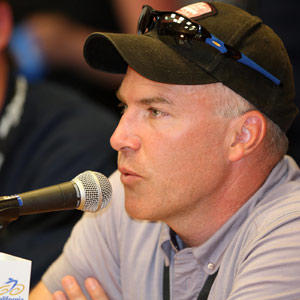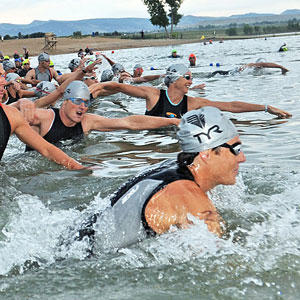Messick on Boulder, etc.

SLOWTWITCH: That’s a coup, getting a course like that in Boulder, finishing on Pearl Street, so absorbed into the community rather than skirting the edge. Who got that course?
ANDREW MESSICK: Dave Christen. I did the Boulder 70.3 last year. Dave pulled me aside and said, “What do you think about a full in Boulder?” If you can get it done, extraordinary. He pulled it altogether. This is his baby. It’s a fine piece of work. Real leadership. We’re super excited.
ST: You have 10 U.S. races now. Full distance races. How many registrations are you processing now per year in the U.S.?
AM: I think we’ll have close to 30 thousand.
ST: For 70.3?
AM: It’s more. I don’t know exactly how may more. Maybe 40 to 50 thousand?
ST: We’re talking a poll right now of North American triathlon race directors. About 150 have answered, and here’s what they say about short course races: twenty-eight percent report that their year-over-year numbers are level. Twenty-nine percent say their numbers are up. Thirty-seen percent say they’re down. By far, their biggest concern is the influx of new races. Sixty-five percent say this is a problem, that the numbers aren’t down in general, rather registrants are spread out over too many races. Do you think the ecosystem is in trouble because of an oversaturation of events?
AM: There are a lot of races, a proliferation of races. No doubt about that. Too many? I don’t know. I certainly don’t think there are too many good races. Here, as well as at our races in Europe and in Asia-Pacific, customers have high expectations. Part of what you need to be able to deliver as an RD is an extraordinary race experience. If you can’t deliver that, you should expect athletes will flow to races that can deliver that. I don’t think there are too many terrific races out there. For people to prosper at any distance you need to deliver a race experience. If you do that you’ll be fine.
ST: In that same poll we note that the predominance of race directors say their numbers at half-distance and longer are flat or are up, that is, more report an increase in numbers than report a decrease in registration numbers. Half-distance races are healthier. Do you feel as if you fell into clover by running a race series geared toward success as the race distance increases?
AM: We play at the Olympic level as well, and realize that this is not what we do best. Where I think we as an organization have unique success is when we deliver the very high touch, extraordinary athlete experience, at distances where there is tremendous emotional engagement by the athlete. The 70.3 is a great distance. Stiff challenge for everyone. But it doesn’t require the level of commitment you need for an Ironman. It’s like the marathon and half-marathon — that shorter distance is a good distance for people. Likewise the 70.3.
ST: Considering your core strengths, as a business, and your recognition of such, what is the future of the 5150 series?
AM: I think there’s a future for Olympic distance and shorter racing linked to us. We encourage the athletes to race shorter distances. That’s part of the Swim Smart initiative. We have an opportunity to continue to drive shorter distance events, but increasingly they will not be races that we own.
ST: When I survey these RDs 12 percent say that an Ironman race in their area helps their numbers. Twenty-eight percent say an Ironman race hurts their numbers. I can see how Ironman can either help or hurt, depending on Ironman’s posture when it enters a community. Can you tell me how Ironman views its place in local ecosystems?
AM: What we’ve seen is that the act of putting an IM race in a community increases athletes — increases those who want to race and those who want to accept the challenge. We have the Boulder Tri Series. We now have a full suite of races in that town, Olympic races, a half and a full. Customers, triathletes in general, view the shorter stuff differently, economics are different, we’re not organized in a way that enables us to own races and compete in the short distance.
ST: Boulder can be a proxy, it seems to me, for how Ironman comports itself in local ecosystems. Dave Christen has short races, a half and a full, and he’s fully invested in the health of everything on the calendar. Do you think this could or should be a model for how Ironman insinuates itself into local communities, especially if your model going forward is to not own the shorter distance events that take place around an Ironman? I think it serves the full distance event if the short events are helped, not hurt, by the full distance event’s presence on the schedule.
AM: That’s the larger truth here. I think there are people who at one level or another put markers in the back of their heads, I’d like to do an IM. Time and circumstances don’t always conspire to make that happen at 25 or 35 years old, so there’s unfinished business. There’s also an enormous number of people who, when they start racing, think what’s next? So, where do our athletes come from? There’s an important role for shorter races, because it’s the entry point for our athletes, and we’re mindful of that. It was the original idea for 5150. Execution-wise we didn’t get it right. Different skill to be able to organize a race at our high touch, high cost model. Plenty of people organize shorter races, we want those guys to succeed.
ST: Is there going to be an Ironman Asheville? It’s a great location for an Ironman, but the course, the swim venue, presents challenges.
AM: We’re still going through the process. We expect to have a late season race in the Southeastern U.S., which means Tennessee, North Carolina, South Carolina.
ST: Let’s talk about drug testing. You saw that Virginia Berasategui just returned a positive A sample. But she did not test positive in any of her Ironman races, including her two wins at Lanzarote. I’ve heard she was not tested when she finished third in Kona in 2009, and when she won Wildflower that same year she was almost certainly not tested, because non-Olympic-style racing is an almost automatic no-test race. Those who race in your races pay $600,000 or more, in the aggregate, into a post set up exclusively for testing. It’s a mystery how much USAT pays for testing at non-ITU-style events, even though that organization funded mostly by the non-ITU races that sanction with it, which include WTC, Rev3, Life Time and the other non-ITU pro race series. To me, this is an unsustainable problem and I predict a reckoning sometime soon. I think USAT, WTC and USADA all are coming under increasing scrutiny for the opaque nature of their anti-doping efforts.
AM: I don’t think our anti-doping efforts are opaque. We published our stats last week, I tweeted it. I’m proud of the work we’re doing, The easiest thing for us to do is kick the can over to USADA and USAT, we’ve taken the position that we are going to take this on, it is expensive. It’s a misnomer that the pros are funding it. We could easily justify that the money be used for something else. The $895 they pay, they otherwise race for free all over the world. That’s us doing the right thing. If anything, the Lance Armstrong affair showed us the level of institutionalized sophistication in cycling, and I don’t believe we have that in the sport of triathlon. The sport is by and large clean. We’re doing what we can within the limits of technology. But it’s a problem you never win. The day any sport— soccer, triathlon, track and field — says, “We win,” that “win” is never going to be declared.


